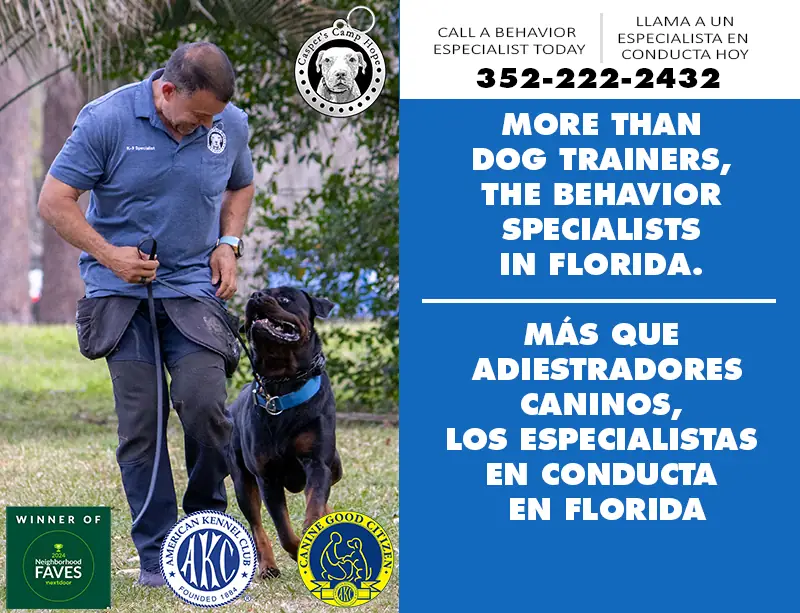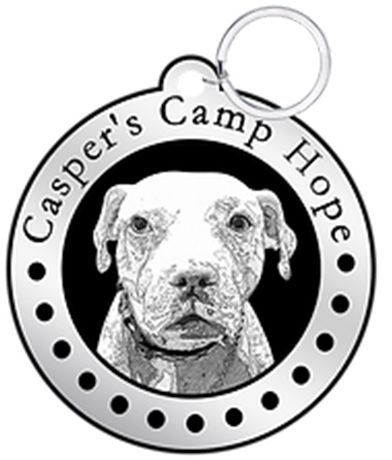If walking your dog through Haile Plantation, Tioga, Jonesville, Archer, Duckpond, Suburban Heights, Millhopper, or University Park feels like running an obstacle course of barking, lunging, and apologizing… you’re in the right place.
Leash reactivity is one of the top reasons people reach out for dog training and dog behavior modification at Casper’s Camp Hope in Gainesville. And it’s not just here—families from all over Alachua County and nearby cities like Alachua, Newberry, High Springs, and Ocala, Florida are dealing with the same thing.
Let’s walk through a clear, step‑by‑step framework to help your leash reactive dog.
Step 1: Understand What Leash Reactivity Really Is
Before we fix it, we need to define it.
A leash reactive dog might:
- Explode into barking or growling when they see another dog
- Hit the end of the leash so hard you’re pulled off balance
- Seem “fine” off leash but turn into a different dog on leash
This is where leash reactive dog training and leash reactivity dog training come in.
Leash Reactivity vs Aggression: Why It Matters
Many owners quietly wonder, “Is my dog aggressive?”
Here’s a simple way to think about leash reactivity vs aggression:
Leash reactivity:
Big reaction on leash, often from fear, frustration, or confusion. The dog feels trapped and overreacts.Aggression:
More serious intent to harm, bite history, or dangerous behavior patterns.
A lot of dogs in Gainesville and Ocala that look aggressive on leash are actually reactive and can improve dramatically with the right blend of dog training vs behavior modification.
Step 2: Set Your Dog Up for Success (Not Failure)
Our area is busy. Between UF traffic, neighborhood dogs behind fences, and weekend trips to Ocala, Florida, your dog is constantly bombarded.
To start changing things, you need to reduce the intensity of what they’re dealing with.
Practical Setup Tips
- Choose quieter streets in Haile Plantation or Suburban Heights at first
- Walk at off‑peak times in Duckpond or Millhopper
- Avoid narrow, crowded sidewalks until your dog has more skills
This isn’t “hiding.” It’s smart leash reactivity dog training—working under threshold so your dog can actually learn.
Step 3: How to Desensitize a Reactive Dog (Without Overwhelming Them)
If you’re asking, “How to desensitize a reactive dog?” think of it like a dimmer switch, not an on/off button.
The Desensitization Formula
Find the Distance Where Your Dog Notices but Stays Calm
That might be across the street or even farther at first.Reward Calm, Not Chaos
When your dog glances at a trigger and then looks back at you, mark and reward. This is the core of leash reactive dog training.Gradually Move Closer Over Time
Only when your dog is consistently calm at the current distance.
This is slow, intentional dog behavior modification, not a quick fix—but it works.
Step 4: How to Socialize a Reactive Dog Safely
A huge search we see is:
- “How to socialize my reactive dog?”
- “How to socialize a reactive dog without making it worse?”
The answer is: structure and control.
Socialization Do’s and Don’ts
Don’t:
- Throw your dog into a crowded dog park in Gainesville or Ocala
- Let unknown dogs rush up nose‑to‑nose on tight leashes
- Force your dog to “get over it” while they’re screaming at the end of the leash
Do:
- Start with visual exposure from a safe distance
- Use calm, neutral dogs in controlled setups
- Work with a trainer who understands dog behavior modification, not just sit and stay
Good socialization for a reactive dog is about emotional safety, not just “more dogs.”
Step 5: Dog Training vs Behavior Modification – What Does Your Dog Need?
Here’s a quick breakdown:
Dog training:
Teaching skills like sit, down, heel, place, recall. Essential, but mostly about surface behavior.Dog behavior modification:
Changing how your dog feels about triggers—dogs, people, being alone, new environments. Critical for leash reactivity and separation anxiety in dogs.
Most leash reactive dogs in Gainesville, Alachua County, and Ocala do best with both: solid obedience plus targeted behavior work.
Step 6: Don’t Ignore Separation Anxiety in Dogs
Many leash reactive dogs also struggle with separation anxiety in dogs:
- Barking or howling when left alone
- Destroying crates or doors
- Pacing and panicking as you get ready to leave
In those cases, we build a separation anxiety dog training plan alongside leash work. A calmer dog at home is usually a calmer dog on leash.
Step 7: Use Daycare & Boarding the Right Way
If you use dog daycare or dog boarding, they should reinforce your training, not undo it.
Dog Daycare Gainesville FL
The right dog daycare Gainesville FL for a sensitive or reactive dog should:
- Have staff trained in dog behavior and body language
- Run structured, supervised groups
- Respect your dog’s limits and triggers
Dog Boarding Gainesville FL
The best dog boarding Gainesville FL option will:
- Keep routines predictable
- Follow your training commands and rules
- Avoid overwhelming your dog with too much, too fast
When daycare and boarding are aligned with your leash reactivity dog training plan, progress is faster and more stable.
Local Success Story: From “We Dread Walks” to “Let’s Go!”
A family from University Park came to us with a young dog who:
- Screamed and lunged at every dog they saw
- Pulled so hard they were afraid of falling
- Made them avoid busy Gainesville streets and trips to Ocala, Florida
They were exhausted and embarrassed.
Our Approach
- Start with a calm, thorough assessment
- Build a custom leash reactive dog training plan with distance work and rewards
- Layer in dog behavior modification and impulse control at home
- Support progress with carefully managed time in our dog daycare Gainesville FL and dog boarding Gainesville FL programs
The Result
Within weeks, they saw real change.
Within a couple of months, they were walking through their neighborhood and visiting friends in Alachua and Newberry without feeling like every walk was a crisis.
FAQ: Leash Reactive Dogs in Gainesville, Alachua County & Ocala
Q: Is my dog aggressive or just leash reactive?
A: That’s the heart of leash reactivity vs aggression. Many dogs that look scary on leash are actually overwhelmed, not truly aggressive. A professional evaluation is the safest way to know.
Q: How to socialize my reactive dog safely?
A: Use distance, calm setups, and a trainer who knows how to socialize a reactive dog without flooding them. Avoid chaotic dog parks at first.
Q: How to desensitize a reactive dog at home?
A: Start with low‑intensity triggers, reward calm, and go slowly. If you get stuck, that’s when leash reactivity dog training with a pro helps.
Q: Can daycare help my reactive dog?
A: The right dog daycare Gainesville FL can help if it’s structured and behavior‑aware. The wrong one can overwhelm your dog and set you back.
Q: Do you work with dogs from outside Gainesville?
A: Yes. We regularly see dogs from across Alachua County and nearby cities, including Alachua, Newberry, High Springs, and Ocala, Florida.
Ready for Calmer Walks and a Calmer Dog?
If every walk in Gainesville, Alachua County, or Ocala feels like a battle, you don’t have to keep doing this alone.
Reach out to Casper’s Camp Hope Dog Training, the behavior specialists in Gainesville Florida.
Let’s build a clear plan, blend dog training with dog behavior modification, and help your leash reactive dog finally breathe and walk calmly by your side.




